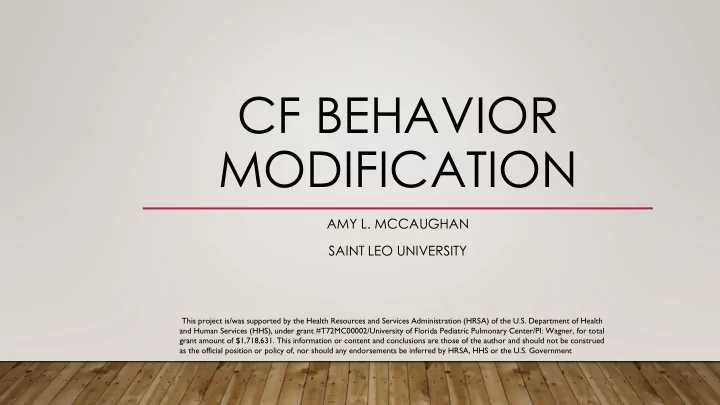

CF BEHAVIOR MODIFICATION AMY L. MCCAUGHAN SAINT LEO UNIVERSITY This project is/was supported by the Health Resources and Services Administration (HRSA) of the U.S. Department of Health and Human Services (HHS), under grant #T72MC00002/University of Florida Pediatric Pulmonary Center/PI: Wagner, for total grant amount of $1,718,631. This information or content and conclusions are those of the author and should not be construed as the official position or policy of, nor should any endorsements be inferred by HRSA, HHS or the U.S. Government
CO-OCCURRING DISORDERS • Diabetes • Arthroplasty • Osteoporosis • Depression • Anxiety (Naehrig, Chao, & Naehrich, 2017)
EMERGING RESEARCH • Research is beginning to investigate the percentage of CF patients who have the co-occurring disorder of ADHD • One study tested 122 CF patients to determine how many had ADHD - 55 patients (45%) met some criteria for ADHD - 20 patients (16%) met all criteria • ADHD affects 5%-12% of the general population- this study highlights the higher rate of the diagnosis in the CF population (Cohen-Cymberknoh, et al., 2015)
EFFECT OF ADHD IN CF POPULATION • Increased time spent in clinic • Decreased school performance when the child is able to attend school • Decrease in the ability to form and maintain social relationships
ADHD EFFECT ON CF • Decrease in the ability to exercise emotional control • Increase in frustration with the parent/guardian and provider • Increased defiance and lack of compliance with at home treatment (Forner, et al., 2016)
GOALS OF ADDRESSING ADHD IN CF CLINIC • Decrease wait time in clinic which could assist in reducing the number of no call/no show to clinic • Increase compliance with at home treatments that could assist in lowering the rate of hospitalizations • Increased collaboration between parent/guardian, provider, and child
BEHAVIOR CHART • Uses behavior modification to increase child’s participation during clinic appointments • Each provider determined expected behavioral goals for their specialty • Creates a stronger working relationship with parent/guardian
REFERENCES • Naehrig, S., Chao, C.-M., & Naehrich, L. (2017). Cystic fibrosis diagnosis and treatment. Deutsches Aerteblatt International, 564-574. • Cohen-Cymberknoh, M., Tanny, T., Blau, H., Kaosh, D., Mussaffi, H., Nir, V., . . . Berger, I. (2015). 300 Prevalence and characteristics of attention deficit hyperactivity disorder (ADHD) in patients with cystic fibrosis (CF). Journal of Cystic Fibrosis, 297-300. DOI: 10.7759/cureus.3048 • Forner, C. B., Miranda, B. R., Foreta, I. B., Castellar, R. G., Diago, C. C., & Casas, A. M. (2016). ADHD symptoms and peer problems: Mediation of executive function and theory of mind. Psicothema 29(4), 514-519. DOI: 10.7334/psicothema2016.376
Recommend
More recommend